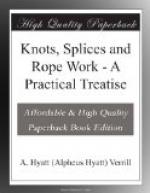and under or behind the standing part, as shown in
A, Fig. 30. The end of the rope may then
be laid over and under the standing part and back over
itself. This knot may be instantly released by
merely pulling out the toggle. Almost as quickly
made and unfastened is the “Slippery Hitch”
(Fig. 32). To make this, run the end of the rope
through the ring or eye to which it is being fastened,
then back over the standing part and pull a loop,
or bight, back through the “cuckold’s neck”
thus formed (Fig. 33). To untie, merely pull
on the free end. Two half-hitches, either around
a post or timber or around the standing part of the
rope, make an ideal and quickly tied fastening (Figs.
34 and 35). To make these, pass the end around
the post, ring, or other object, then over and around
the standing part between the post and itself, then
under and around the standing part and between its
own loop and the first one formed. After a little
practice you can tie this knot almost instantly and
by merely throwing a couple of turns around a post,
two half-hitches may be formed instantly. This
knot will hold forever without loosening, and even
on a smooth, round stick or spar it will stand an
enormous strain without slipping. A more secure
knot for this same purpose is the “Clove Hitch”
(Fig. 36), sometimes known as the “Builders’
Hitch.” To make this, pass the end of rope
around the spar or timber, then over itself; over and
around the spar, and pass the end under itself and
between rope and spar, as shown in the illustration.
The Clove hitch with ends knotted becomes the “Gunners’
Knot” (Fig. 37). These are among the most
valuable and important of knots and are useful in
a thousand and one places. The Clove hitch will
hold fast on a smooth timber and is used extensively
by builders for fastening the stageing to the upright
posts. It is also useful in making a tow-line
fast to a wet spar, or timber, and even on a slimy
and slippery spile it will seldom slip. For this
purpose the “Timber Hitch” (Fig. 38) is
even better than the Clove hitch. It is easily
made by passing the end of a rope around the spar
or log, round the standing part of the rope and then
twist it three or more times around, under and over
itself. If you wish this still more secure, a
single half-hitch may be taken with the line a couple
of feet further along the spar (Fig. 39).
[Illustration: FIG. 30.—Lark’s head with toggle (A).]
[Illustration: FIG. 31.—Lark’s head with toggle (A) withdrawn.]
[Illustration: FIG. 32.—Slippery hitch (complete).]
[Illustration: FIG. 33—Slippery hitch (tying).]
[Illustration: FIGS. 34 and 35.—Half-hitches.]
[Illustration: FIG. 36 A.—Clove hitch or builder’s hitch (tying).]
[Illustration: FIG. 36 B.—Clove hitch (complete).]
[Illustration: FIG. 37.—Gunner’s knot.]
[Illustration: FIG. 38.—Timber hitch.]




